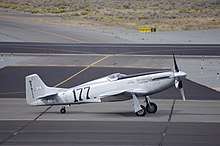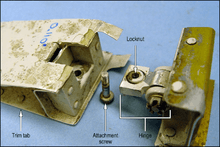2011 Reno Air Races crash
On September 16, 2011, The Galloping Ghost, a highly modified North American P-51D Mustang racing aircraft, crashed into spectators while competing at the Reno Air Races, killing the pilot, James K. "Jimmy" Leeward, and 10 people on the ground. Sixty-nine more people on the ground were injured.[1][2] It was the third-deadliest airshow disaster in U.S. history, following accidents in 1972 in Sacramento, California and 1951 in Flagler, Colorado.[3]
 The Galloping Ghost photographed before the accident | |
| Accident | |
|---|---|
| Date | September 16, 2011 |
| Summary | Mechanical failure |
| Site | Reno, Nevada, U.S. 39°39′37.12″N 119°52′40.81″W |
| Total fatalities | 11 |
| Total injuries | 69 |
| Aircraft | |
| Aircraft type | North American P-51D Mustang |
| Aircraft name | The Galloping Ghost |
| Operator | Aero Trans Corp. |
| Registration | NX79111 |
| Flight origin | Reno Stead Airport, Reno, Nevada, U.S. |
| Destination | Reno Stead Airport |
| Occupants | 1 |
| Crew | 1 |
| Fatalities | 1 |
| Survivors | 0 |
| Ground casualties | |
| Ground fatalities | 10 |
| Ground injuries | 69 |
Accident
Leeward, 74, and his Mustang were in third place and had just rounded pylon number 8 when the airplane abruptly pitched up, rolled inverted, then nosedived.[4] The aircraft hit the apron at over 400 miles per hour (640 km/h) in front of the grandstands in an area containing box seating, disintegrating on impact. There was no fire.
Seven people, including the pilot, died at the crash site;[5] four died later in the hospital.[6][7] The weekend's remaining races at the Reno Air Races were canceled.
Aircraft
The Mustang, named The Galloping Ghost, was a highly modified former military plane that in 2010 had come out of retirement after undergoing major modifications, including removal of the underbelly radiator and installation of a 'boil-off' cooling system, as well as other modifications that the owner describes as designed to make the plane more efficient. The former United States Air Force aircraft, serial number 44-15651, was owned by Aero Trans Corp in Ocala, Florida.[8] The wings had been clipped a further 3 ft (0.9 m) each side on top of the 4 ft (1.2 m) reduction in span earlier in its life.[9]
The aircraft had a long history of successful competition in air races dating back to the National Air Races from 1946 to 1949 in Cleveland.[10] It was flown by a series of pilots under a variety of names, including Miss Candace from 1969 to 1978 and Jeannie in 1981.[11]
Leeward called the modifications of the plane "radical." He said the oil system was similar to an oil cooling system in the Space Shuttle.[9][12] The canopy is about the size of the ones on Formula One aircraft. The modifications were meant to improve aerodynamics by reducing drag and hence increase top speed.[9]
Previous incidents
On September 18, 1970, the airplane (then known as Miss Candace) crashed while attempting an emergency landing caused by an engine failure during that year's Reno Air Races at Reno-Stead Airport. During the landing the plane's longer propeller, modified for racing, clipped the runway surface, causing the plane to drift off the edge of the runway, collapsing part of the landing gear, causing only minor injuries to pilot Dr. Cliff Cummins.[13]
In 1998, another modified P-51 Mustang, Voodoo Chile, lost a left trim tab during the Reno Air Races. The pilot, Bob "Hurricane" Hannah, reported that the airplane pitched up, subjecting him to more than 10 g and knocking him unconscious. When he regained consciousness, the plane had climbed to more than 9,000 feet (2,750 m), and he brought it in for a safe landing.[14][15] This aircraft (having been renamed to Voodoo) was in attendance at the 2011 race, and nearby at the time of the accident.
In 1999, another highly modified P-51 called Miss Ashley II, piloted by Gary Levitz, experienced rudder flutter during an unlimited race at the Reno Air Races. The airframe broke up, killing Levitz.[16]
Investigation

The day after the crash, the National Transportation Safety Board (NTSB) began examining whether part of the empennage had come off before the crash.[17] A photograph taken just before the crash showed the airplane inverted and part of the left elevator trim tab missing.[17][18]
On October 21, 2011, Federal crash investigators with the National Transportation Safety Board said that they found no readable onboard video amid the debris of the racing plane. However, they were still attempting to extract information from an onboard data memory card found among damaged aircraft components and other debris scattered over more than two acres following the crash, as well as hundreds of photos and dozens of videos provided by spectators.[19]
The NTSB thoroughly investigated the extensive modifications made to the airplane. The modifications had made the aircraft lighter and reduced drag but decreased stability. Leeward took the plane to 530 mph (850 km/h) during the race, about 40 mph (65 km/h) faster than he had gone previously.[20] There was evidence of extreme stress on the airframe demonstrated by buckling of the fuselage aft of the wing and gaps appearing between the fuselage and the canopy during the flight (visible in high-resolution photographs taken by spectators).
The investigation report, released in August 2012, found that the probable cause of the crash was reused single-use locknuts in the left elevator trim tab system that loosened. This led to a fatigue crack in an attachment screw and allowed the trim tab to flutter. This flutter caused the trim tab link assembly to fail which led to the loss of control of the aircraft. Untested and undocumented modifications to the airplane contributed to the accident. Particularly, the right trim tab had been fixed in place. Had both trim tabs been operational, the loss of the left trim tab alone may not have caused the loss of control. When the trim tab failed, Leeward experienced 17 g, which quickly incapacitated him and likely rendered him unconscious.[21][22]
In 2012, the NTSB released seven safety recommendations to be applied to future air races. These included course design and layout further away from the spectators stands, pre-race inspections, airworthiness of aircraft modifications, FAA guidance, pilot g-force awareness, and ramp safety.[23]
References
- "Plane crashes into crowd at Reno air races". NBC News. September 16, 2011. Retrieved September 16, 2011.
- "Death toll following Reno air disaster reaches 9; 69 injured". BNO News. September 17, 2011. Archived from the original on 2011-09-26. Retrieved September 17, 2011.
- Johnson, Bridget (2011-09-19). "World's Worst Air Show Crashes". World News. Archived from the original on 2015-04-03. Retrieved 2011-09-20.
- "'Mass casualties' reported after plane crashes at Nevada air show". CNN. September 16, 2011.
- "Death toll from Nevada air crash rises to nine". Reuters. 2011-09-17.
- Ritter, Ken (1970-09-18). "Plane in NV crash had 'radical' changes to compete". ajc.com. Retrieved 2011-09-19.
- Frank, Thomas (2011-09-18). "10th person dies from Reno air race crash". usatoday.com. Retrieved 2011-09-19.
- "P-51D Mustang/44-15651". FAA Registry. Retrieved 2011-09-17.
- Davison, Budd (May 2011). "Reviving a Ghost". Sport Aviation. Experimental Aircraft Association. 60 (5): 34–39. Archived from the original on September 23, 2011. Retrieved September 17, 2011.
- "Steve C Beville Obituary". EAA. Archived from the original on 3 December 2011. Retrieved 17 September 2011.
- "The Galloping Ghost Returns To Reno". Pacific Flyer. Archived from the original on 10 November 2010. Retrieved 17 September 2011.
- "June 2011 National Championship Air Races Podcast". YouTube. 2011-06-16. Retrieved 2011-09-19.
- "NTSB Aircraft Accident Report OAK71FXQ16 North American P-51D, registration: N79111". National Transportation Safety Board. Retrieved July 11, 2017.
- "Voodoo - 98 NCAR". Warbird.com. Retrieved 2011-09-19.
- Grantham, Kevin; Grantham, Jackie (27 September 1998). "Reno Unlimiteds Turn 35". AVweb. Retrieved 19 September 2011.
- "National Transportation Safety Board Aviation Accident Final Report Accident Number: LAX99FA311". National Transportation Safety Board. May 9, 2001. Retrieved July 11, 2017.
- Barboza, Tony (September 17, 2011). "Reno air races crash: NTSB investigates elevator trim tab". Latimesblogs.latimes.com. Retrieved 2011-09-19.
- "US vintage aircraft crashes into crowd". Telegraph. London. September 17, 2011. Retrieved 2011-09-19.
- "NTSB: No Video From P-51 in Reno Air Show Crash". ABC. October 21, 2011.
- Ritter, Ken, "NTSB: Trim tab failure caused 2011 race crash", Military Times, 27 August 2012
- Accident Brief, NTSB/AAB-12/01 PB2012-916203
- "Pilot/Race 177, The Galloping Ghost North American P-51D, N79111 Reno, Nevada September 16, 2011 Accident Brief NTSB/AAB-12/01" Archived October 14, 2012, at the Wayback Machine
- "Aviation accident at the Reno Air Race". www.ntsb.gov. Retrieved 2019-03-24.
External links
- A recording of the emergency radio traffic, including Reno EMS (REMSA), fire, and police
- Local professor 'shaken' after catching air race crash on videokatu.com. September 20, 2011.
- Information about the plane (44-15651) on MustangsMustangs.com
- Check-Six.com - Fatal Accidents associated with the National Championship Air Races
- Final NTSB Accident Brief AAB-12/01